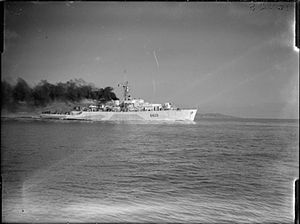Loch-class frigate

HMS Loch Fyne
|
|
| Class overview | |
|---|---|
| Name: | Loch class |
| Operators: | |
| Preceded by: | River class |
| Succeeded by: | Bay class |
| Completed: | 30 |
| Cancelled: | 54 |
| General characteristics | |
| Type: | Frigate |
| Displacement: | 1,435 long tons (1,458 t) |
| Length: | 307 ft 9 in (93.8 m) |
| Beam: | 38 ft 9 in (11.8 m) |
| Draught: | 8 ft 9 in (2.7 m) |
| Installed power: |
|
| Propulsion: |
|
| Speed: | 20 knots (37 km/h; 23 mph) |
| Range: | 9,500 nmi (17,600 km; 10,900 mi) at 12 knots (22 km/h; 14 mph) |
| Complement: | 114 |
| Sensors and processing systems: |
|
| Armament: |
|
The Loch class was a class of anti-submarine (A/S) frigate built for the Royal Navy and her Allies during World War II. They were an innovative design based on the experience of three years of fighting in the Battle of the Atlantic and attendant technological advances.
The Lochs were based upon the hull of the preceding River class with increased sheer and flare to improve seakeeping and modified to suit it to mass pre-fabrication, with sections riveted or welded together at the shipyard. Accordingly, as many curves as possible were eliminated, producing a noticeable kink in the main deck where the increased sheer forwards met the level abreast the bridge.
The fighting capability of the Loch class was a great jump forward, being based around the new Squid ahead-throwing A/S mortar. Previously, escorts had attacked with depth charges, requiring the attacking vessel to pass over the submerged submarine and drop warheads over the stern. Consequently, the ahead-looking ASDIC (sonar) set lost contact at the vital moment before the weapons were launched, allowing a skilled submarine commander to take successful evasive action. Squid, however, lobbed three 12-inch (300 mm), 390 pound warheads up to 600 yards (550 m) ahead of the launching vessel falling in a triangular pattern with sides of 40 yards (37 m). As the clockwork fuses detonated the warheads at a depth determined by the ships' ASDIC set, the Squid therefore attacked in full ASDIC contact for greater accuracy and lethality. Two mortars were carried, with the bombs set to explode at different depths in order to create a convergent pressure wave to crush the hull of a submarine. The first successful "kill" was by Loch Killin on 31 July 1944, sinking the German submarine U-333. Such was the utility of Squid that depth charge carriage was reduced to only 15, with a single rack and a pair of throwers being carried at the stern, resulting in a clear quarterdeck compared to the eight throwers, two racks and stowage for 100 plus charges in the Rivers.
...
Wikipedia
